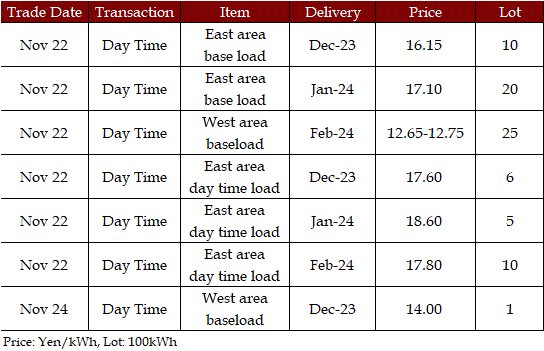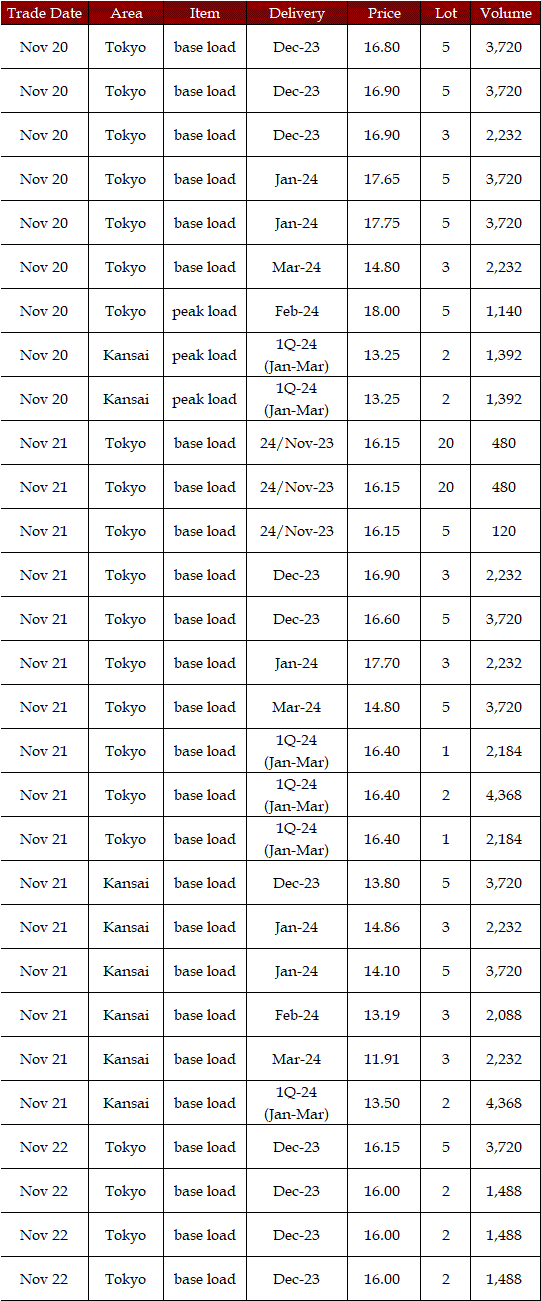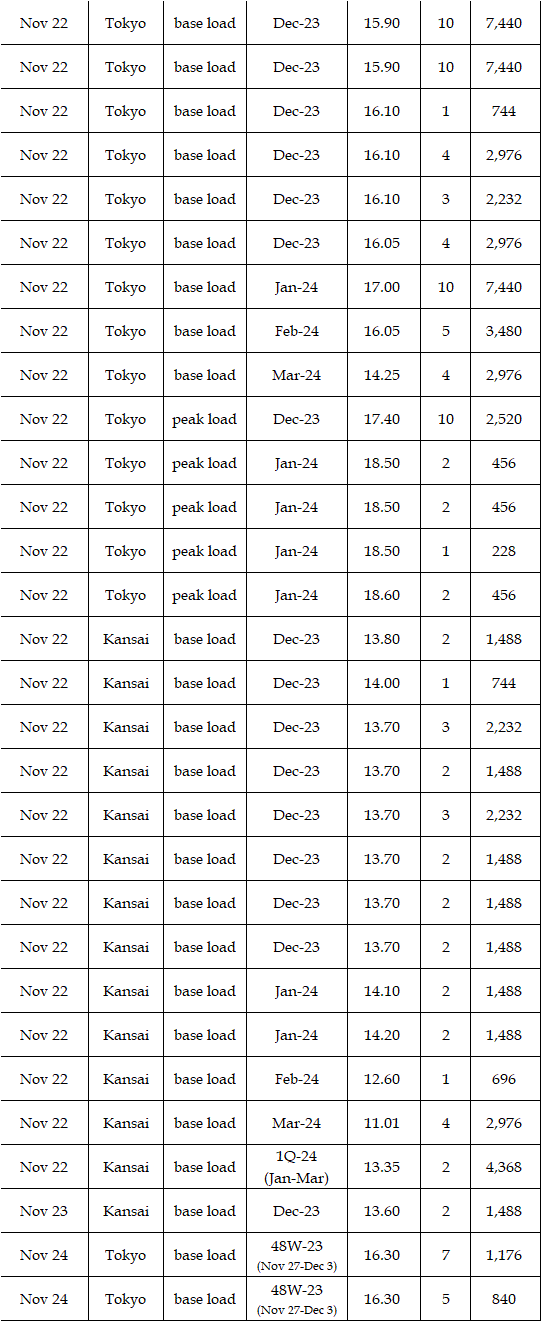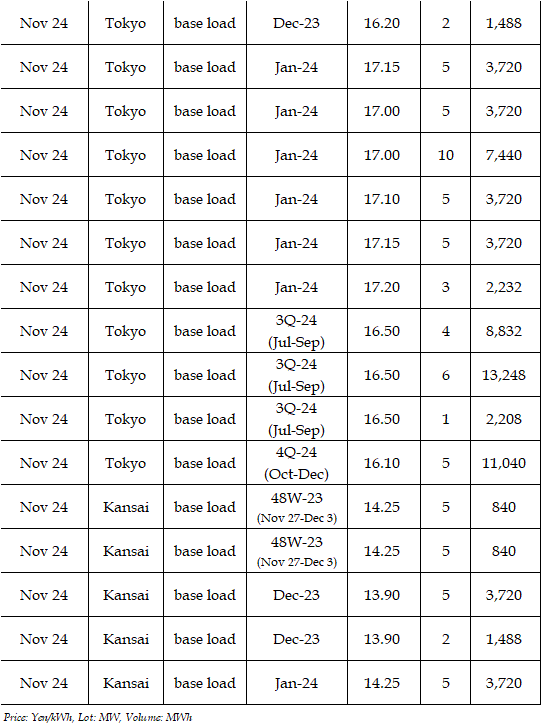|
In the day-ahead market on JEPX (Japan Electric Power Exchange), the 24-hour spot power prices on a weekly average basis for Nov 20-24 delivery weakened from the previous week in both East Japan and West Japan. The temperatures were relatively comfortable in many areas while the weather remained mostly sunny except in North Japan, allowing heathy output from photovoltaic generation. Thus, supply-demand fundamentals loosened up led by day time, and a combination of growing offers and shrinking bids pressured down spot prices. Meanwhile, ongoing maintenance works at the Soma-Futaba Line connecting Tohoku and Tokyo left spot prices depressed in Hokkaido and Tohoku through the middle of the week. But the maintenance was completed in the latter half of the week, almost erasing price decoupling between Tohoku and Tokyo. As a result, spot prices in Hokkaido and Tohoku resumed moving closer to those in Tokyo.
In Tokyo and Kansai, the key areas in East Japan and West Japan, the 24-hour average posted a difference in favor of the East by Yen 3.79 for Nov 20 delivery, Yen 2.84 for Nov 21 delivery, Yen 2.36 for Nov 22 delivery, Yen 1.33 for Nov 23 delivery, and Yen 1.44 for Nov 24 delivery.
In the fuel markets, LNG prices slumped from the end of the previous week. Crude oil prices turned higher while coal prices were little changed.
DES Northeast Asia spot LNG prices hovered in the low $16 level per mmBtu for prompt January 2024 arrival as of the latter half of the week (Nov 22), compared with the high $16 level as of the end of the previous week (Nov 17). The market came under pressure as the DES Northeast Asia market attracted more sellers amid limited buying interest. A softness in European natural gas prices also served as a bearish factor. The Ministry of Economy, Trade and Industry (METI) announced on Nov 22 that Japan's LNG inventories for power generation grew to 2.49 mil mt as of Nov 19, up 80,000mt from 2.41 mil mt in the previous week. Power producers continued to beef up stockpiling for the winter period. The level compared with 2.55 mil mt as of end-November last year and the average of past five years at 2.12 mil mt.
FOB Newcastle thermal coal prices in Australia hovered in the high $128 level for January 2024 loading as of the latter half of the week. The level was up moderately from the mid $127 level as of the end of the previous week. The market lacked direction for the lack of fresh incentives, but apparently found support from stronger crude oil prices.
In the crude oil market, WTI crude for January 2024 stood in the mid $76 level as of morning on Nov 24 while Brent crude for January 2024 was trading in the mid $81 level. Compared with the end of the previous week, WTI rose by nearly $0.50 while Brent gained about $1. At the beginning of the week, the market was lifted by prospects for an additional production cut by the Organization of the Petroleum Exporting Countries (OPEC) and non-OPEC producers led by Russia, or OPEC plus. But the cartel postponed a ministerial meeting to Nov 30 from the original plan to gather on Nov 26. Perceptions loomed key oil producers were not fully positive yet on the output reduction. In addition, weekly oil statistics released on Nov 22 by the US Energy Information Administration (EIA) showed an increase in crude oil inventories. The buildup was far larger than market expectations, spurring selling in crude futures and paring the early gain in crude futures.
The actual highest price during the week was at Yen 22.29 in seven areas from Tokyo to Kyushu for Nov 22 delivery. Meanwhile, the actual lowest price during the week was at Yen 0.01 in three areas including Hokkaido, Tohoku, Kyushu for Nov 20-22 delivery.
By area, the weekly average of the 24-hour spot prices was at Yen 9.21 in Hokkaido and Tohoku, down Yen 0.98 from the previous week, Yen 16.27 in Tokyo, down Yen 1.46, Yen 14.77 in Chubu, down Yen 1.01, Yen 13.93 in Hokuriku, down Yen 1.47, Yen 13.92 in Kansai and Chugoku, down Yen 1.48, Yen 13.87 in Shikoku, down Yen 1.53, and Yen 12.82 in Kyushu, down Yen 1.59.
In the JEPX auction, volumes of offers were 939.40 mil kWh on a weekly average basis, up 11.5% from the previous week. Meanwhile, bids on a weekly average basis shrank by 3.4% to 810.23 mil kWh. The weekly average of trade volumes increased by 1.2% to 621.07 mil kWh.
Power demand in nine areas of Japan during Nov 20-24 was a combined 11,242.27 mil kWh, down 2.8% from 11,566.54 mil kWh during Nov 13-17. The figure was unchanged from the corresponding period a year earlier. Demand during Nov 21-25, 2022 after day of week adjustment was 11,239.53 mil kWh.
In the JEPX forward market, no deals were confirmed during Nov 20-24.
Deals reported on TOCOM (Tokyo Commodity Exchange) during Nov 20-24 were as below.

Deals reported on EEX (European Energy Exchange) during Nov 20-24 were as below.



In the fifth week of November, spot power prices are expected to rise from the fourth week. The temperatures are forecast to be relatively high in the first half of the week, but lower temperatures are expected to give a boost to heating demand from the middle of the week. Thus, spot power prices are likely to track an upward trend in line with growing demand. The new month of December will kick off on Friday with a start of the peak-demand winter period. But supply is expected to remain stable while some retail players are locking in prices through bilateral OTC deals. Market players doubt if spot power prices will show extreme spikes without a loss of sizable generation capacity.

|







